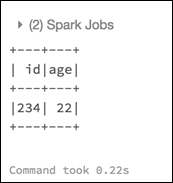Querying with the DataFrame API
As noted in the previous section, you can start off by using collect(), show(), or take() to view the data within your DataFrame (with the last two including the option to limit the number of returned rows).
Number of rows
To get the number of rows within your DataFrame, you can use the count() method:
swimmers.count()
This gives the following output:
Out[13]: 3
Running filter statements
To run a filter statement, you can use the filter clause; in the following code snippet, we are using the select clause to specify the columns to be returned as well:
# Get the id, age where age = 22
swimmers.select("id", "age").filter("age = 22").show()
# Another way to write the above query is below
swimmers.select(swimmers.id, swimmers.age).filter(swimmers.age == 22).show()The output of this query is to choose only the id and age columns, where age = 22:

If we only want to get back the name of the swimmers who have an eye color that begins with the letter b, we can use a SQL-like...




































































